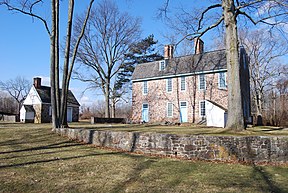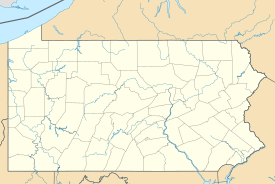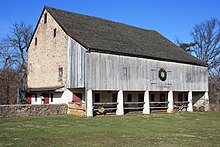Graeme Park
| Graeme Park | ||
|---|---|---|
| National Register of Historic Places | ||
| National Historic Landmark | ||
|
Mansion and Kitchen House (2006) |
||
|
|
||
| location | Horsham , Montgomery County , Pennsylvania | |
| Coordinates | 40 ° 13 '0 " N , 75 ° 9' 0" W | |
| Built | 1721/1722 | |
| NRHP number | 66000672 | |
| Data | ||
| The NRHP added | October 15, 1966 | |
| Declared as an NHL | October 9, 1960 | |
Graeme Park is a historically significant mansion in Horsham , Montgomery County , Pennsylvania . It is listed on the National Register of Historic Places and has National Historic Landmark status . Graeme Park is the only surviving Pennsylvania colonial governor's residence .
history
Graeme Park was built in 1721/1722 by the then governor of the Province of Pennsylvania , Sir William Keith, 4th Baronet and was originally called Fountain Low . The thesis advocated in the middle of the 20th century that the manor house was only a malt house has since been invalidated. In addition to the main building, a “long house” was built as slave accommodation and a barn by 1726. After the Penn family removed him from office and he was bankrupt, Keith moved to Fountain Low in 1726 until he returned to the Kingdom of Great Britain in 1728 . His wife and daughter, who was married to Thomas Graeme, remained in the Thirteen Colonies . Graeme was a surgeon at Pennsylvania Hospital in Philadelphia and a Supreme Court Justice for the colony. In 1739 Fountain Low came into his possession; he gave it its current name and converted it into a summer residence. For this purpose, the malt house was converted into a residential building in 1739/1740. After Graeme's death, his daughter Elizabeth and her husband Henry Hugh Fergusson could only maintain the property for a short time due to financial difficulties, which is why they put it up for sale in 1773. Probably because of the long distance from Philadelphia for the time, no interested party was found.
In 1778 the government of the now independent state of Pennsylvania confiscated Graeme Park because Elizabeth's husband was on the side of the loyalists in the American Revolutionary War . After the war, Elizabeth, abandoned by Fergusson, got the property back until she sold it to her nephew William Smith in 1791. He parceled out the property and sold the parts individually. In 1801, Samuel Penrose acquired the built-up area. In 1810 he built a new house elsewhere and since then there has been no record of whether Graeme Park was still inhabited afterwards. Archaeological research suggests that people lived here around the middle of the 19th century. In the first half of the 19th century, a barn was built on the property. In 1920 Penrose's descendants, the Strawbridge couple, acquired Graeme Park and bequeathed it to the Commonwealth of Pennsylvania in 1958 . A kitchen house was built in the 1960s.
On October 9, 1960, it was granted National Historic Landmark status. In October 1966, the entry in the National Register of Historic Places followed. Graeme Park is the only surviving governor's residence in the colonial Province of Pennsylvania. The building is considered to be one of the most outstanding examples of Georgian colonial architecture , to which the wood paneling in the interior, initiated by Graeme, contributes in particular.
Building description

The mansion is two and a half stories high and has a mansard roof . The footprint is just under 18 x 6.50 m, with the outer walls made of brown field stone being 0.6 m thick. The simple frames of the narrow and tall doors and windows accentuate the sober exterior facade, the front of which faces south. In contrast to this is the generous and highly skilled Georgian-style wood paneling inside, which dates back to 1739. On the ground floor there is a central entrance hall and a salon, the extensive decor of which, in addition to the wood paneling, includes a frieze in the Greek style that completely surrounds the room and a mantelpiece with architrave and ornamental gable.
In addition to the manor house, there is also a barn as well as a kitchen house and an outhouse, both of which are reconstructions. The remains of a cowshed, a smokehouse, a slave quarters and a chicken coop came to light during an excavation in the 1970s. In addition, a stream flows through the property and there is a pond.
literature
- Lorett Treese: Graeme Park: Pennsylvania Trail of History Guide. Stackpole Books, Mechanicsburg 2003, ISBN 0-8117-2785-8 .
- John L. Cotter, Daniel G. Roberts, Michael Parrington: The Buried Past: An Archaeological History of Philadelphia. University of Pennsylvania Press, Philadelphia 1994, ISBN 0-8122-3142-2 , pp. 383-388 (= Graeme Park: From Malt House to Georgian Mansion ).
- Patricia Heintzelman: National Register of Historic Places Inventory: Nomination Form; here: Graeme Park. In: National Register Information System. National Park Service , August 30, 1974; Retrieved November 15, 2019 (677 KB).
Web links
- Graeme Park on the Valley Forge Tourism & Convention Board website
Remarks
- ↑ Lorett Treese: Graeme Park: Pennsylvania Trail of History Guide. P. 7.
- ↑ Patricia Heintzelman: National Register of Historic Places Inventory: Nomination Form; here: Graeme Park. P. 5.
- ↑ Lorett Treese: Graeme Park: Pennsylvania Trail of History Guide. P. 5.
- ↑ Patricia Heintzelman: National Register of Historic Places Inventory: Nomination Form; here: Graeme Park. Pp. 5-7.
- ↑ Lorett Treese: Graeme Park: Pennsylvania Trail of History Guide. P. 5.
- ↑ Listing of National Historic Landmarks by State: Pennsylvania. National Park Service , accessed November 15, 2019.
- ^ Graeme Park on the National Register Information System. National Park Service , accessed November 16, 2019.
- ↑ Lorett Treese: Graeme Park: Pennsylvania Trail of History Guide. P. 5.
- ↑ Patricia Heintzelman: National Register of Historic Places Inventory: Nomination Form; here: Graeme Park. P. 2.
- ↑ Patricia Heintzelman: National Register of Historic Places Inventory: Nomination Form; here: Graeme Park. P. 2.


